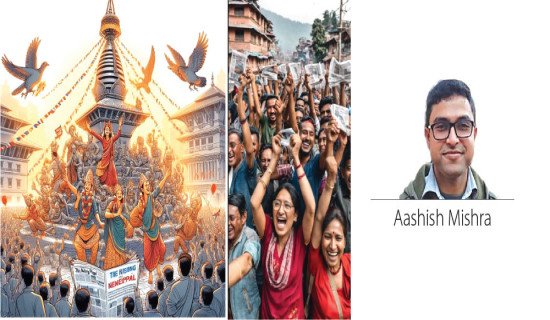- Tuesday, 2 September 2025
The Meaning Of Malamas
Tuesday marked the beginning of Malamas. Therefore, from July 18 to August 16, Hindus in Nepal and across the world will not celebrate any major festival or hold auspicious family or social functions like weddings, Pujas, oblations, etc.
Malamas is known as the month without occasions and is also called the Adhik Mas (Extra Month) or the Purushottam Month. But there is so much to this month aside from this that is worth discussing.
For starters, it occurs every 32 months and 16 days as a way to align the lunar and solar calendars. Hinduism places much importance on lunar cycles as they guide the Tithis (lunar days).
But the Earth’s revolution around the sun is also not ignored as evidenced by the value placed on occasions like Sankrantis. Nepal’s Bikram Sambat calendar is a lunisolar almanack that incorporates both the lunar and solar elements of the year into a single unified dating system. However, when separate, the lunar and the solar calendars have a difference of 11 days between the two. This is because the solar year is 365 days long while a lunar year is 354 days long.
This 11-day difference becomes 33 days over three years which gets added to the lunar calendar as an additional month; hence the name Adhik Mas. Concerning its title Purushottam Month, this comes from the month’s association with Lord Vishnu.
The story of the demon Hiranyakashipu states that he had a special boon from Brahma that allowed him to wreak havoc in the universe. The boon was that he could not be killed by any human or animal, inside or outside any structure, on land or in the air, either during the day or at night, using any living or non-living thing. This made his enemies, namely the gods, powerless against him and he gave them and their worshippers great trouble. His son, though, turned out to be a great devotee of God Vishnu and through his devotion, the lord appeared in the form of Narasingh and slew the wicked Asura.
Narsingh was the perfect incarnation to kill Hiranyakashipu. He was part human and part lion (hence, neither fully human nor animal). He appeared at twilight (which is neither day nor night). He sat at the threshold of a courtyard (which is neither outdoors nor indoors), placed the demon on his lap (neither land nor air) and ripped his abdomen open with his claws (which are neither living nor non-living weapons).
Some stories say that Hiranyakashipu’s boon also made him impervious to death in any of the 12 months of the year. That is why Vishnu created an additional 13th month – Adhik Mas – to kill him.
Meanwhile, another story anthropomorphises Malamas and says that Vishnu adopted it to keep it from humiliation. All 12 months of the year had a specific deity watching over it. But Malamas, being an irregular period that came only once in three years, did not have that. Thus, it felt belittled and went to Lord Vishnu, also known as Purushottam, for help.
Seeing how sad the Malamas was, Vishnu took guardianship of it and gave it his name, making it the Purushottam Month we know today.
As Malamas is not part of the regular 12 months and is made up of ‘leftover’ days, there are no astrologically propitious moments (Saait) in this month.
Couples are also asked to refrain from intercourse during Malamas as the child conceived may not have a healthy and happy life. Therefore, couples who have been married for less than a year are separated during this time and wives usually live with their parents this month.
However, Malamas is not a month of complete religious silence. Because Lord Vishnu is considered to watch over this month, activities related to him, like visiting Vishnu shrines and reciting the Purushottam Mahatmya are encouraged. Those who donate to the needy at this time are believed to gain great merit.
Also, there are no restrictions on holy activities done daily and rituals related to events beyond human control like births and deaths. Some people keep a fast, either for the whole month or some days in the month. People also refrain from eating fish as it is one of the 10 primary avatars of Vishnu. Great fairs are organised in the Matsya Narayan Temples of Kathmandu Valley (Narayan is another name for Vishnu). Malamas has very little impact on everyday life though.














